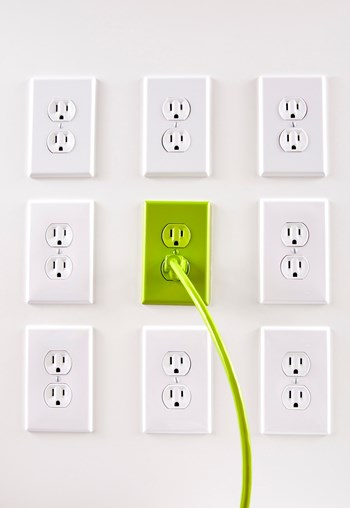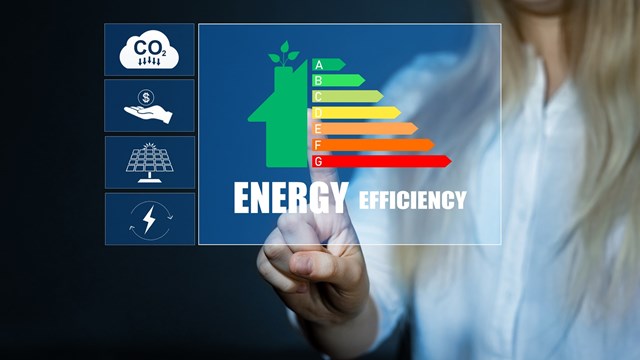
Ask anyone to draw a picture of a light bulb, and odds are the sketches are all going to look quite similar—a circular incandescent bulb with the threaded end and tungsten filament that most lamps have always used. You know the ones: when someone gets an idea, it's the bulb that's supposed to appear over their head. But if you want a really good idea, try replacing those old-school bulbs with newer fluorescent ones—you'll not only save money, you'll be helping out the environment by using far less energy as well.
The Inside Scoop
Technically, there's not much you need to know about measuring energy. Lighting efficacy is a measure of efficiency and measured in lumens per watt of electricity. A lumen is a unit of light output and a watt is a unit of energy. It gives a measure of how much light you get per unit of energy, so you can compare.
When you are choosing lighting for the inside of your co-op or condo, not only should your lighting scheme and design be aesthetically pleasing and safe, but you should look to save energy as well.
"For an indoor environment, there are really only two choices—incandescent and fluorescent—but the lighting efficacy of the incandescent is the worst," says Zack Lilienfeld, owner and consulting engineer for Integrity Engineering, LLC in Margate City. "The standard lighting found in older light fixtures are the incandescent bulbs, but these are not energy efficient."
Indoor lighting should be functional but also be energy-efficient. Although co-op and condo owners may not always think of lighting as a way to save a lot of money, it is one area that should be considered since it is so simple to do.
"The energy efficient lighting you should work with is compact fluorescent lighting, or CFL," adds Paul Young, national marketing manager for Niagara energy conservation products in Cedar Knolls. "The manufacturers of CFL make the basic equivalents of the regular incandescents that are commonly used in homes right now."
To light the same area illuminated by a standard 100-watt incandescent light requires only a 23-watt fluorescent. A 75-watt incandescent can be replaced with a 20-watt fluorescent, a 60-watt with a 15-watt, and a 40-watt with an 11-watt, for example. A 100-watt incandescent bulb burns that much energy to produce its light. The equivalent CFL only burns at a quarter of that rate (23 watts) to throw four times the light, so you are saving both in replacement costs and power consumption.
"When you replace a 60-watt incandescent with a 15-watt compact fluorescent, it gives you the same light output using a quarter of the energy," says Phil DiBetta, account executive for AM Conservation Group in Hackettstown, who adds that fluorescents have come a long way indeed from the buzzing, flickering, greenish lights of yesterday's corporate cubicles and high school chemistry labs. Fluorescents once were primarily used for commercial illumination, but in the last 20 years the compact fluorescents have become important for residential applications. They come in all shapes and sizes, throw a more attractive glow, and are great for saving energy.
"And they're made these days to be 'instant-on,'" says DiBetta. "In the old days, they had magnified circuitry, and it took time for them to warm up. You would get a little flicker before the light finally came on. Now, when you turn them on, it's like a regular light—it's instantaneous. It's hard to get people to buy into the new lights, though, because when they think fluorescent, they think of that old style of lamps."
The Right Light for the Right Room
Most people's lighting needs differ from room to room throughout their home. A new kind of fluorescent, called a 'mini-spiral,' is available for table lamps and ceiling fixtures, and can be used in any room in the house—but great as they are, however, fluorescents may not always be the best choice.
"In the bathroom, you want lighting with a good color rendition—that is the color spectrum that the light produces," says Lilienfeld. "A woman putting on her makeup wants to have the same light she'll be seen in later. You want to have the right tone, and so you need the right color rendition for clothing, makeup, and so forth. For this, you may want to use a higher efficiency incandescent like a quartz halogen."
Halogens are an incandescent light often used in car headlights that are about 10 to 15 times more efficient than the standard incandescent models, but still not in the same league as the CFL.
Then there's the case of storage closets or other areas where you're not using light too often. "You wouldn't want a fluorescent then because you're not running it too long so there's no opportunity to really save," Lilienfeld says. "Anything that's run for more than eight hours a day, I would recommend replacing it with a fluorescent fixture."
Seeing Outdoors
Whether it's for a porch, patio or a spotlight for the property, CFLs are available for all outdoor needs of a homeowner or board.
"They make exterior fluorescents so you can use them whether covered or not," DiBetta says. "We have a wet location line where you can put it right outside in the elements and it works just as well. And they work up to negative-30 degrees Fahrenheit and work in the rain."
With any new bulb or fixture, it's important that you check the packaging and installation instructions to make sure that the product is intended for outdoor use. Young warns that the market is now flooded with cheap imitations so he advises to check that what you or your HOA staff is using is a CFL with an Energy Star label on the packaging. Also look for bulbs that are rated for at least 10,000 hours.
"They even have complete fixtures where you can replace your old 60-watt porch light with a 15-watt porch light, which uses a quarter of the energy and lasts up to five years or 10,000 hours," DiBetta continues. "The initial up-front cost is a little bit more, but you save it in the long run with energy savings and with replacement bulb savings. You would have to buy five light bulbs to get it the same amount of life as one fluorescent."
Outdoor fixtures can cost as much as $150 for the more decorative models. Outdoor lighting is an important part of the overall security of a suburban homeowner community. Anywhere an incandescent bulb is being used in a stairwell, there is a fluorescent counterpart that will last longer and use less energy.
"Lights will burn out less and so it helps with security issues," as well as saving money and energy, Young says.
There are also high-pressure sodium light fixtures that can be used in these instances. "They have an excellent length of life—about 18,000 hours—and get 90 to150 lumens per watt, but the color rendition isn't nearly as good [as with fluorescents]," Lilienfeld says. "Metal halide lamps are also a good choice if you are looking for your car in a garage. You find these used in atriums or courtyards too."
Lilienfeld believes that when dealing with locations where security is an issue, you should replace any older incandescent fixtures right away. "Anywhere where people walk, you should replace with fluorescent," he says. "It will cut by two-thirds the amount of electricity and last eight to10 times longer."
Old Habits Die Hard
The biggest problem with the newer fluorescent fixtures is that they do cost more. Even though they last so much longer, people just don't seem to want to do practice simple math.
"They may ask 'Why should I buy this for three dollars when I can buy a regular bulb for 60 cents?'" Young says. "These compact fluorescent bulbs—the ones that are Energy Star approved—are oftentimes a 10,000-hour bulb that will last 10 times longer. It will pay for itself just by the amount of regular bulbs you would use over a seven-year period."
Indoor light fixtures can run up to $50 apiece. It will cost $25 to $50 for a good compact fluorescent fixture. You can buy light bars for closets that look like fluorescent tubes but are smaller for around $45 apiece.
Yes, it might be a little pricey at first, but association boards shouldn't be scared off by the initial bills because the long-term benefits of replacing the light fixtures will be far greater in cost.
"It's worth it but it's tough to educate people," says DiBetta. "You will save energy and money."
Another problem with switching to fluorescent lighting is that people don't like to stray from what they know.
"People might be reluctant to use these because they look different, they aren't 'normal' looking," says Young. "They have a spiral, spring-like twist to them. They are afraid if the bulb is exposed at all, if the fixture cover doesn't cover the whole length of the bulb, people are a little weird about the bulb sticking out of that fixture cover. It doesn't look terrible, but it's not what they're used to."
Keeping Control
Another area where associations can save money with more energy-efficient lighting is in common areas. Often times when there are clubhouses, bathrooms, storage closets or other areas that people share, lights are on all the time when no one is using the rooms.
"Why have a light on 24 hours a day when it's not being used continuously?" Lilienfeld asks. "You can install infrared sensors instead of a light switch. Motion sensors are also popular, and can turn lights on when someone enters. They cost between $20 and $50 a sensor. Dimmer switches are also good for those areas."
So the next time a light goes out and you are thinking of just heading to the store to buy some regular light bulbs, consider switching to fluorescent fixtures instead.
"It's an easy thing to do in your home or association to make a definite impact on your energy bill," Young says. "It's no more difficult than screwing in a light bulb. You pay a little bit more as an initial investment, but it pays for itself rather quickly, and the quality of the light is very good. You are doing something good for the environment, and you're helping the community consume less energy."
Keith Loria is a freelance writer and a frequent contributor to The New Jersey Cooperator.






Leave a Comment